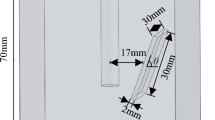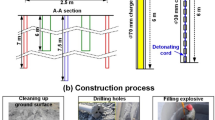Abstract
Roof-cutting blasting by explosives involves certain operational risks and is prone to cause damage to surrounding rock. Accordingly, a new non-explosive directional rock-breaking technology called Instantaneous Expansion with a Single Fracture (IESF) has been developed. This paper focuses on the research of the crack propagation behavior and damage extent of rock mass under the action of IESF. Firstly, the directional rock-breaking principle of IESF is analyzed, and the theoretical radius of the crushed zone (\(R_{\text{c}}\)) and fracture zone (\(R_f\)) for conventional blasting (CB), shaped-charge blasting (SCB), and IESF under cylindrical charge conditions are derived. Subsequently, a field comparative experiment of the three methods was conducted. The results showed that CB produced cracks in random orientations around the hole wall, SCB produced secondary cracks in addition to two primary cracks in splitting direction, and the cracks produced by CB and SCB contain both Mode I and Mode II. Conversely, IESF only produces Mode I cracks in the presplitting direction. Finally, \(R_{\text{c}}\) and \(R_f\) of the three numerical models considering the rock mass heterogeneity were statistically analyzed, the results demonstrate that \(R_{\text{c}}\) (IESF) < \(R_{\text{c}}\) (SCB) < \(R_{\text{c}}\) (CB), while \(R_f\) (IESF) > \(R_f\) (SCB) > \(R_f\) (CB). The statistical analysis of the monitoring point pressure and Young's modulus during the damage process further verified the directional rock-breaking mechanism of IESF. The research results have improved the theoretical system of IESF and contributed to the promotion and application of IESF technology.
Highlights
-
Through field tests, the crack propagation behavior of the rock mass in the borehole under conventional blasting (CB), shaped-charge blasting (SCB), and instantaneous expansion with a single fracture (IESF) was investigated.
-
Theoretical radius of the crushed zone (\(R_c\)) and fracture zone (\(R_f\)) of rock mass under the action of CB, SCB, and IESF under cylindrical charge conditions were derived.
-
Three numerical models considering the heterogeneity of rock mass were established based on the theory of progressive damage failure, and numerical solutions for \(R_c\) and \(R_f\) under three rock-breaking technologies were obtained, verifying the accuracy of the analytical solutions.
-
The superiority of IESF in directional rock-breaking was verified through comparative analysis of the damage range of rock mass under three rock-breaking technologies






















Similar content being viewed by others
Data availability
Some or all data that support the findings of this study are available from the corresponding author upon reasonable request.
References
Arshadnejad S (2019) Design of hole pattern in static rock fracture process due to expansion pressure. Int J Rock Mech Min Sci. https://doi.org/10.1016/j.ijrmms.2019.104100
Chen ZH (2016) Research on Propagation of Blasting Crack between Adjacent Blast Holes in Rock. Xi’an University of Science and Technology, Xian
Cheng YG, Lu YY, Ge ZL et al (2018) Experimental study on crack propagation control and mechanism analysis of directional hydraulic fracturing. Fuel 218:316–324. https://doi.org/10.1016/j.fuel.2018.01.034
Cho SH, Cheong SS, Yokota M, Kaneko K (2016) The dynamic fracture process in rocks under high-voltage pulse fragmentation. Rock Mech Rock Eng 49:3841–3853. https://doi.org/10.1007/s00603-016-1031-z
Dai J (2001) Calculation of radii of the broken and cracked areas in rocl by a long charge explosion. J Liaoning Tech Univ 20:144–147
Donzé FV, Bouchez J, Magnier SA (1997) Modeling fractures in rock blasting. Int J Rock Mech Min Sci 34:1153–1163. https://doi.org/10.1016/S1365-1609(97)80068-8
Gao F, Ye T, Liu XW (2015) Study on calculations of exploding gas pressure of detonators based on explosive force and covolume. J Prejectiles Rickets Missiles Guid 35:2–6
Gao YB (2018) Study on Key Issues of 110 Mining Method Used in a Thick Coal Seam - A Case Study in Ningtiaota Coal Mine. China University of Mining and Technology, Beijing
Gao YB, Wang YJ, Yang J et al (2019) Meso- and macroeffects of roof split blasting on the stability of gateroad surroundings in an innovative nonpillar mining method. Tunn Undergr Sp Technol 90:99–118. https://doi.org/10.1016/j.tust.2019.04.025
Guo S, Zhang Q, He MC et al (2022) Numerical investigation on rock fracture induced by a new directional rock-breaking technology. Eng Fract Mech 268:108473. https://doi.org/10.1016/j.engfracmech.2022.108473
He MC, Cao WF, Shan RL, Wang SR (2003) New Blasting technology - Bilateral cumulative tensile explosion. Chinese J Rock Mech Eng 22:2047–2051
He MC, Wang Q, Wu QY (2021) Innovation and future of mining rock mechanics. J Rock Mech Geotech Eng 13:1–21. https://doi.org/10.1016/j.jrmge.2020.11.005
He MC, Zhu GL, Guo ZB (2015) Longwall mining “cutting cantilever beam theory” and 110 mining method in China-The third mining science innovation. J Rock Mech Geotech Eng 7:483–492. https://doi.org/10.1016/j.jrmge.2015.07.002
Henrich J (1987) The dynamics of explosion and its use. Science Press, Beijing
Hu Y, Lu W, Chen M et al (2014) Comparison of blast-induced damage between presplit and smooth blasting of high rock slope. Rock Mech Rock Eng 47:1307–1320. https://doi.org/10.1007/s00603-013-0475-7
Jeong HY, Jeon BK, Choi SB, Jeon SK (2020) Fracturing behavior around a blasthole in a brittle material under blasting loading. Int J Impact Eng. https://doi.org/10.1016/j.ijimpeng.2020.103562
Jia H, Xu Y (2007) Study on stress damage zone in excavation of rock mass. Chin J Rock Mech Eng 26:3489–3492
Jiang LL (2010) Mechanism and Application of Directional Fracture Blasting with Slotted Cartridge. China University of Mining and Technology, Beijing
Lekontsev YM, Sazhin PV (2013) Application of the directional hydraulic fracturing at Berezovskaya Mine. J Min Sci 44:127–147. https://doi.org/10.1029/rf003p0127
Li QM, Meng H (2003) About the dynamic strength enhancement of concrete-like materials in a split Hopkinson pressure bar test. Int J Solids Struct 40:343–360. https://doi.org/10.1016/S0020-7683(02)00526-7
Li XF, Li HB, Liu K et al (2017) Dynamic properties and fracture characteristics of rocks subject to impact loading. Chinese J Rock Mech Eng 36:34
Liang CY, Wu SR, Li X (2015) Research on micro-meso characteristics of granite fracture under uniaxial compression at low and intermediate strain rates. Chinese J Rock Mech Eng 34:2977–2986. https://doi.org/10.13722/j.cnki.jrme.2014.0701
Liang CY, Zhang QB, Li X, Xin P (2016) The effect of specimen shape and strain rate on uniaxial compressive behavior of rock material. Bull Eng Geol Environ 75:1669–1681. https://doi.org/10.1007/s10064-015-0811-0
Liang HD, Guo PF, Sun DJ et al (2020) A study on crack propagation and stress wave propagation in different blasting modes of shaped energy blasting. J Vib Shock 78:45
Lu YB, Li QM, Ma GW (2010) Numerical investigation of the dynamic compressive strength of rocks based on split Hopkinson pressure bar tests. Int J Rock Mech Min Sci 47:829–838. https://doi.org/10.1016/j.ijrmms.2010.03.013
McHugh S (1983) Crack extension caused by internal gas pressure compared with extension caused by tensile stress. Int J Fract 21:163–176. https://doi.org/10.1007/BF00963386
Melnikov NV (1962) Influence of explosive charge design on results of blasting. In: International Symposium on Mining Research. pp 147–155
Nilson RH, Proffer WJ, Duff RE (1985) Modelling of gas-driven fractures induced by propellant combustion within a borehole. Int J Rock Mech Min Sci 22:3–19. https://doi.org/10.1016/0148-9062(85)92589-6
Niu LL, Zhu WC, Li S, Liu XG (2020) Spalling of a one-dimensional viscoelastic bar induced by stress wave propagation. Int J Rock Mech Min Sci 131:104317. https://doi.org/10.1016/j.ijrmms.2020.104317
Paine AS, Please CP (1994) An improved model of fracture propagation by gas during rock blasting-some analytical results. Int J Rock Mech Min Sci 31:699–706. https://doi.org/10.1016/0148-9062(94)90009-4
Patel SM, Sondergeld CH, Rai CS (2017) Laboratory studies of hydraulic fracturing by cyclic injection. Int J Rock Mech Min Sci 95:8–15. https://doi.org/10.1016/j.ijrmms.2017.03.008
Tang CA (1997) Numerical simulation of progressive rock failure and associated seismicity. Int J Rock Mech Min Sci 34:249
Wang WL (1984) Drilling and Blasting. China Coal Industry Publishing House, Beijing
Wu YZ, Kang HP (2017) Pressure relief mechanism and experiment of directional hydraulic fracturing in reused coal pillar roadway. J China Coal Soc 42:1130–1137. https://doi.org/10.13225/j.cnki.jccs.2016.1677
Xu JZ, Zhai C, Qin L, Yu GQ (2017) Evaluation research of the fracturing capacity of non-explosive expansion material applied to coal-seam roof rock. Int J Rock Mech Min Sci 94:103–111. https://doi.org/10.1016/J.IJRMMS.2017.03.004
Xu JZ, Zhai C, Ranjith PG et al (2019a) Investigation of non-explosive expansion material in roof caving field application. Int J Rock Mech Min Sci 120:50–57. https://doi.org/10.1016/J.IJRMMS.2019.05.004
Xu XD, He MC, Zhu C et al (2019b) A new calculation model of blasting damage degree—Based on fractal and tie rod damage theory. Eng Fract Mech 220:106619. https://doi.org/10.1016/j.engfracmech.2019.106619
Yang XJ, Yuan D, Xue HJ et al (2021) Research on roof cutting and pressure releasing technology of cumulative blasting in deep and high stress roadway. Geotech Geol Eng 39:2653–2667. https://doi.org/10.1007/s10706-020-01649-z
Yin XT, Ge XR, Li CG, Wang SL (2010) Influence of loading rates on mechanical behaviors of rock materials. Chinese J Rock Mech Eng 29:34
Zhang BP, Zhang QM, Huang FL (2001) Detonation physics. The Publishing House of Ordnance Industry, Beijing
Zhang M, Wu HJ, Li QM, Huang FL (2009) Further investigation on the dynamic compressive strength enhancement of concrete-like materials based on split Hopkinson pressure bar tests. Part I: Experiments. Int J Impact Eng 36:1327–1334. https://doi.org/10.1016/j.ijimpeng.2009.04.009
Zhang Q (2022) Investigation on principle and application of directional rock breaking by instantaneous expansion. China University of Mining and Technology, Beijing
Zhang Q, He MC, Guo S et al (2022a) Investigation on the key techniques and application of the new-generation automatically formed roadway without coal pillars by roof cutting. Int J Rock Mech Min Sci 152:23. https://doi.org/10.1016/j.ijrmms.2022.105058
Zhang Q, He MC, Wang J et al (2022b) Investigation of a non-explosive directional roof cutting technology for self-formed roadway. Int J Min Sci Technol 32:997–1008. https://doi.org/10.1016/j.ijmst.2022.07.006
Zhang Q, He MC, Wang J et al (2020a) Instantaneous expansion with a single fracture: A new directional rock-breaking technology for roof cutting. Int J Rock Mech Min Sci. https://doi.org/10.1016/j.ijrmms.2020.104399
Zhang Q, Tao ZG, Yang C et al (2022c) Experimental and numerical investigation into the non-explosive excavation of tunnels. J Rock Mech Geotech Eng 14:1885–1900. https://doi.org/10.1016/j.jrmge.2022.02.003
Zhang QB, Zhao J (2014) A review of dynamic experimental techniques and mechanical behaviour of rock materials. Rock Mech Rock Eng 47:1411–1478. https://doi.org/10.1007/s00603-013-0463-y
Zhang XY, Pak RYS, Gao YB et al (2020b) Field experiment on directional roof presplitting for pressure relief of retained roadways. Int J Rock Mech Min Sci. https://doi.org/10.1016/j.ijrmms.2020.104436
Zhou ZL, Zhang GQ, Dong HR et al (2017) Creating a network of hydraulic fractures by cyclic pumping. Int J Rock Mech Min Sci 97:52–63. https://doi.org/10.1016/j.ijrmms.2017.06.009
Zhu WC, Gai D, Wei CH, Li SG (2016) High-pressure air blasting experiments on concrete and implications for enhanced coal gas drainage. J Nat Gas Sci Eng 36:1253–1263. https://doi.org/10.1016/j.jngse.2016.03.047
Zhu WC, Tang CA (2004) Micromechanical model for simulating the fracture process of rock. Rock Mech Rock Eng 37:25–56. https://doi.org/10.1007/s00603-003-0014-z
Zhu WC, Wei CH, Li S et al (2013) Numerical modeling on destress blasting in coal seam for enhancing gas drainage. Int J Rock Mech Min Sci 59:179–190. https://doi.org/10.1016/j.ijrmms.2012.11.004
Acknowledgements
This work was supported by the National Key Research and Development Program of China (No. 2016YFC0600901).
Author information
Authors and Affiliations
Contributions
SG: Writing—Original Draft, Conceptualization, Software, Methodology. QZ: Writing—Review and Editing, Investigation. MH: Supervision, Project administration, Funding acquisition. SJ: Supervision, Writing—Review and Editing. YG: Formal analysis. CW: Visualization.
Corresponding author
Ethics declarations
Conflict of Interest
The authors declare that they have no known competing financial interests or personal relationships that could have appeared to influence the work reported in this paper.
Additional information
Publisher's Note
Springer Nature remains neutral with regard to jurisdictional claims in published maps and institutional affiliations.
Rights and permissions
Springer Nature or its licensor (e.g. a society or other partner) holds exclusive rights to this article under a publishing agreement with the author(s) or other rightsholder(s); author self-archiving of the accepted manuscript version of this article is solely governed by the terms of such publishing agreement and applicable law.
About this article
Cite this article
Guo, S., Zhang, Q., He, M. et al. Crack Propagation Behavior and Damage Extent of Rock Mass under Instantaneous Expansion in Borehole. Rock Mech Rock Eng 57, 869–888 (2024). https://doi.org/10.1007/s00603-023-03584-w
Received:
Accepted:
Published:
Issue Date:
DOI: https://doi.org/10.1007/s00603-023-03584-w




